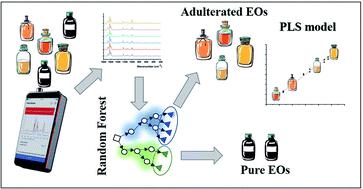当前位置:
X-MOL 学术
›
Anal. Methods
›
论文详情
Our official English website, www.x-mol.net, welcomes your
feedback! (Note: you will need to create a separate account there.)
Smartphone-based handheld Raman spectrometer and machine learning for essential oil quality evaluation
Analytical Methods ( IF 2.7 ) Pub Date : 2021-08-13 , DOI: 10.1039/d1ay00886b Leo Lebanov 1, 2 , Brett Paull 1, 2
Analytical Methods ( IF 2.7 ) Pub Date : 2021-08-13 , DOI: 10.1039/d1ay00886b Leo Lebanov 1, 2 , Brett Paull 1, 2
Affiliation

|
We present a method, utilising a smartphone-based miniaturized Raman spectrometer and machine learning for the fast identification and discrimination of adulterated essential oils (EOs). Firstly, the approach was evaluated for discrimination of pure EOs from those adulterated with solvent, namely benzyl alcohol. In the case of ylang–ylang EO, three different types of adulteration were examined, adulteration with solvent, cheaper vegetable oil and a lower price EO. Random Forest and partial least square discrimination analysis (PLS-DA) showed excellent performance in discriminating pure from adulterated EOs, whilst the same time identifying the type of adulteration. Also, utilising partial least squares regression analysis (PLS) all adulterants, namely benzyl alcohol, vegetable oil and lower price EO, were quantified based on spectra recorded using the smartphone Raman spectrometer, with relative error of prediction (REP) being between 2.41–7.59%.
中文翻译:

基于智能手机的手持式拉曼光谱仪和机器学习用于精油质量评估
我们提出了一种方法,利用基于智能手机的微型拉曼光谱仪和机器学习来快速识别和鉴别掺假精油 (EO)。首先,评估该方法以区分纯 EO 和掺有溶剂(即苯甲醇)的 EO。在依兰-依兰 EO 的情况下,检查了三种不同类型的掺假,溶剂掺假、较便宜的植物油和较低价格的 EO。随机森林和偏最小二乘判别分析 (PLS-DA) 在区分纯 EO 和掺假 EO 方面表现出色,同时识别掺假类型。此外,利用偏最小二乘回归分析 (PLS) 所有掺杂物,即苯甲醇、植物油和低价 EO,
更新日期:2021-08-23
中文翻译:

基于智能手机的手持式拉曼光谱仪和机器学习用于精油质量评估
我们提出了一种方法,利用基于智能手机的微型拉曼光谱仪和机器学习来快速识别和鉴别掺假精油 (EO)。首先,评估该方法以区分纯 EO 和掺有溶剂(即苯甲醇)的 EO。在依兰-依兰 EO 的情况下,检查了三种不同类型的掺假,溶剂掺假、较便宜的植物油和较低价格的 EO。随机森林和偏最小二乘判别分析 (PLS-DA) 在区分纯 EO 和掺假 EO 方面表现出色,同时识别掺假类型。此外,利用偏最小二乘回归分析 (PLS) 所有掺杂物,即苯甲醇、植物油和低价 EO,











































 京公网安备 11010802027423号
京公网安备 11010802027423号